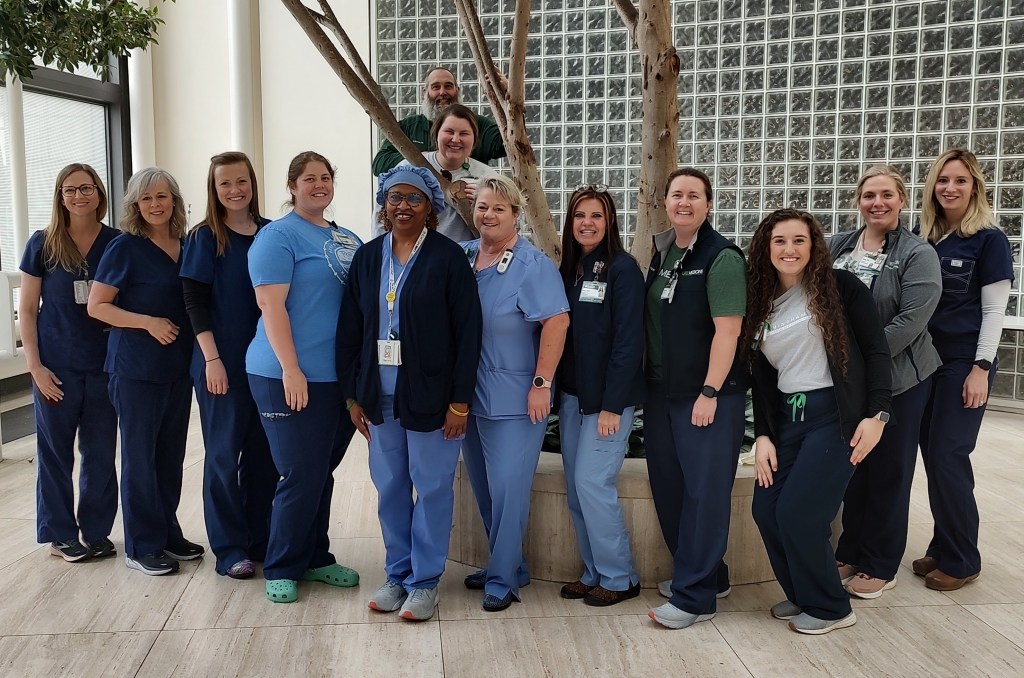
The nurses who work in UAB Medicine’s 170 ambulatory clinics see the delivery of care and patient outcomes from a unique perspective. Is there a way to use their insights to improve UAB Medicine?
That question led to the creation of the Ambulatory Nurse Practice Council (ANPC) by nurses themselves. The council organizes the diverse input of individual nurses and creates actionable, data-driven solutions. Formed in late 2021, the ANPC laid a foundation in 2022 to improve nursing practice, care quality, and patient safety.
Formation and workflow
At first, the ANPC was a small number of nurses who wanted to start a focus group aimed at making modest and sensible practice improvements at UAB Medicine ambulatory clinics, says 2022 ANPC Chair Lauren Salter, RN. “We became a focus group for practice improvements but soon expanded our vision,” she says. “We saw that we could create an avenue to escalate concerns in a way that also suggested solutions, giving nurses a way to affect policy just by communicating.”
The group envisioned data-driven changes that would require partnerships across UAB Medicine to accomplish. Salter and colleagues worked with leadership to form the ANPC, with 45 participants from various clinics and at all levels. Any nurse can participate in the council, which is led by democratically elected officers who serve one-year terms.
The ANPC’s workflow is described below:
- Each monthly meeting is centered on a “roundup,” where members voice concerns or identify trends from their clinics.
- The most common serious or recurring concerns are identified.
- Identified issues are assessed, to determine if there is a quick fix or if a task force is needed to better understand and quantify the problem.
- Resulting task forces may do a literature search, study solutions at other hospitals, and gather more data. Some concerns have a simple solution at the clinical level, while others need to be escalated to leadership.
- The ANPC presents UAB Medicine leadership with proposals that include data, recommended solutions, and possible partnerships needed to accomplish the goals.
- The outcomes of these proposals are monitored by the ANPC on an ongoing basis.
“You can already see our impact in areas ranging from parking deck and transportation improvements and new-employee training materials to reducing Emergency Department volume from our ambulatory clinics,” Salter says.
First-year impact
Three examples of concerns addressed by the ANPC are summarized below:
CONCERN: Staff retention
COVID-19 emphasized the need to do everything possible to nurture and retain nurses. The ANPC formed a task force that zeroed in on onboarding and training as areas needing improvement. “We created a survey for new-hires that ran for six months, with simple questions for determining how effective communication during onboarding had been,” Salter says. Using this input, the task force created a training binder for new employees, which was supported by information gathered during additional polling of clinics. This binder is complete and soon will be rolled out as a resource to be used for the next several years. It directly addresses some of the gaps in understanding and sources of dissatisfaction among new-hires.
CONCERN: Reducing patient falls
Reducing patient falls is a continual concern for ambulatory nurses, and many ANPC initiatives focus on areas where falls could be prevented. The actions described below helped reduce the number of falls from 238 in 2021 to 223 in 2022:
- Environment of care rounds were started, during which nurses eliminate tripping hazards and document their actions in a standardized electronic form for easier access.
- Training on using gait belts (devices used to more safely move patients from bed to wheelchair) was implemented through an educational module assignment. The council itself conducted this training before the educational module was rolled out in March 2022.
- The ANPC worked with Quality and Patient Safety to implement armbands for identifying patients most at risk for falls. In use since in September 2022, these armbands help staff be more mindful in areas with a high number of geriatric patients, including trauma, rheumatology, and cardiac care areas.
Some 6,000 patients per week come into The Kirklin Clinic of UAB Hospital and Whitaker Clinic of UAB Hospital, and getting from their cars to their care destination can include fall hazards. The ANPC worked with UAB Parking & Transportation Services and Quality and Patient Safety to assess common routes to elevators and entrances and make key changes, including using cones instead of curbs where possible, adding signage in elevators, and lighting improvements. “Because we had the data to show how this would be impactful, the improvements were made quickly,” Salter says. Also, the ANPC worked with Guest Services to be more strategic about where wheelchairs are placed and to train staff to encourage their use among patients who may need them.
CONCERN: Reducing Emergency Department congestion and delivering care more quickly
The Ambulatory Intermediate Care Clinic (AICC) uses advanced practice providers to more quickly treat low-acuity patients who otherwise might face long waits in the Emergency Department. Equally important, the clinic helps reduce Emergency Department congestion. The ANPC worked to make sure all UAB Medicine areas received clear education on when it’s appropriate to redirect patients to the AICC.
ANPC task forces may continue their work for years once formed, but the council also sets yearly objectives. Patient education is the major focus for 2023. “The partnerships we are forming now will help us find creative solutions for years to come,” Salter says. “This council is a powerful new avenue for nurses to improve patient care and create work environments that reflect their values.”
This story is part of the Nursing Annual Report 2022. Click here to view the report.
